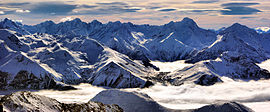Isère
Isère
Isera ( | ||
|---|---|---|
|
Communes 512 | | |
| ^1 French Land Register data, which exclude estuaries and lakes, ponds and glaciers larger than 1 km2 | ||
Isère (
History
Isère is one of the original 83 departments created during the French Revolution on 4 March 1790. It was established from the main part of the former province of Dauphiné.[6] Its area was reduced twice, in 1852 and again in 1967, on both occasions losing territory to the department of Rhône.

In 1852 in response to rapid urban development around the edge of
.Most recently, on 1 April 1971, Colombier-Saugnieu was transferred to Rhône. Banners appeared in the commune's three little villages at the time proclaiming Dauphinois toujours ("Always Dauphinois").
Isère was also the name of the French ship which delivered the 214 boxes containing the components of the Statue of Liberty.
Geography
Isère includes a part of the
Principal towns
The most populous commune is Grenoble, the prefecture. As of 2019, there are 7 communes with more than 20,000 inhabitants:[5]
| Commune | Population (2019) |
|---|---|
| Grenoble | 158,198 |
| Saint-Martin-d'Hères | 37,935 |
| Échirolles | 36,932 |
| Vienne | 29,993 |
| Bourgoin-Jallieu | 28,834 |
| Fontaine | 23,211 |
| Voiron | 20,372 |
Demographics
Inhabitants of the department are called Isérois (masculine) and Iséroises (feminine).
Population development since 1801:
|
| |||||||||||||||||||||||||||||||||||||||||||||||||||||||||||||||||||||||||||||||||
| ||||||||||||||||||||||||||||||||||||||||||||||||||||||||||||||||||||||||||||||||||
| source:[8][9] | ||||||||||||||||||||||||||||||||||||||||||||||||||||||||||||||||||||||||||||||||||
Politics
Departmental politics
The President of the Departmental Council has been Jean-Pierre Barbier of The Republicans (LR) since 2015.
Following the 2021 departmental election, the Departmental Council of Isère (58 seats) was composed as follows:
| Group | Seats | |
|---|---|---|
| • | The Republicans and allies | 26 |
| Socialist Party and allies | 13 | |
| • | Union of Democrats and Independents and allies | 5 |
| French Communist Party and allies | 5 | |
Europe Ecology – The Greens and allies |
4 | |
| • | Independents | 3 |
| • | La République En Marche! |
2 |
Representation in Paris
National Assembly
In the 2022 legislative election, Isère elected the following representatives to the National Assembly:
Senate
In the
Culture

The Grande Chartreuse is the mother abbey of the Carthusian order. It is located 22 km (14 mi) north of Grenoble.
As early as the 13th century, residents of the north and central parts of Isère spoke a dialect of the
Tourism
Isère features many
Grenoble has a dozen museums, including its most famous, established in 1798, the Museum of Grenoble. The European Synchrotron Radiation Facility (ESRF), an international research facility in Grenoble, is also open to visitors.
-
The Grand Veymont
-
The Dent de Crolles
-
Queyras Valley
See also
- Cantons of the Isère department
- Charmant Som
- Communes of the Isère department
- Arrondissements of the Isère department
- Chartreuse Mountains
- Grande Sure
References
- ^ "Répertoire national des élus: les conseillers départementaux". data.gouv.fr, Plateforme ouverte des données publiques françaises (in French). 4 May 2022.
- ^ "Téléchargement du fichier d'ensemble des populations légales en 2021". The National Institute of Statistics and Economic Studies. 28 December 2023.
- ^ "Isère". The American Heritage Dictionary of the English Language (5th ed.). HarperCollins. Retrieved 22 August 2019.
- ^ "Isère". Merriam-Webster.com Dictionary. Retrieved 22 August 2019.
- ^ a b Populations légales 2019: 38 Isère, INSEE
- ^ Frederick Converse Beach; George Edwin Rines (1912). The Americana: a universal reference library, comprising the arts and sciences, literature, history, biography, geography, commerce, etc., of the world. Scientific American compiling department. p. 741.
- ^ Revue du Lyonnais (in French). L. Boitel. 1865. p. 197.
- ^ "Historique de l'Isère". Le SPLAF.
- ^ "Évolution et structure de la population en 2016". INSEE.
- ^ Nationale, Assemblée. "Assemblée nationale ~ Les députés, le vote de la loi, le Parlement français". Assemblée nationale.
External links
- Prefecture website (in French)
- Departmental Council website (in French)
- Coolidge, William Augustus Brevoort (1911). . Encyclopædia Britannica. Vol. 14 (11th ed.). p. 867.










